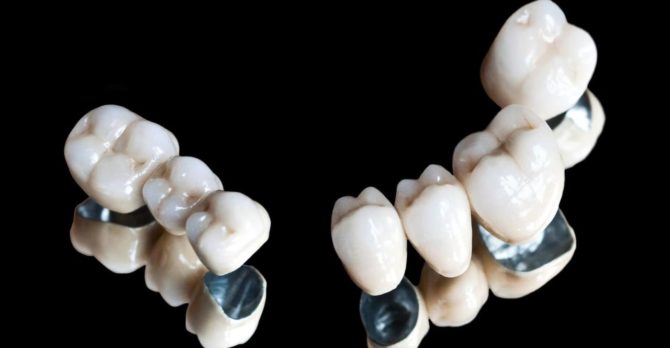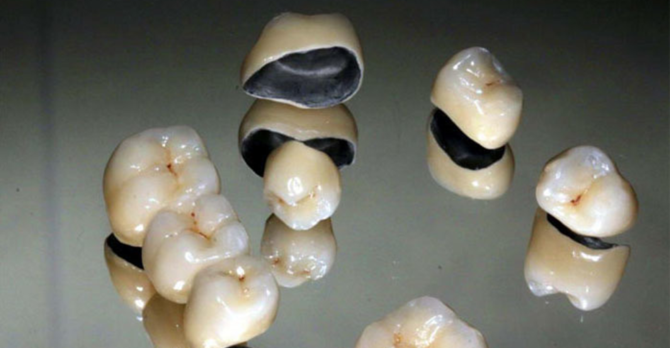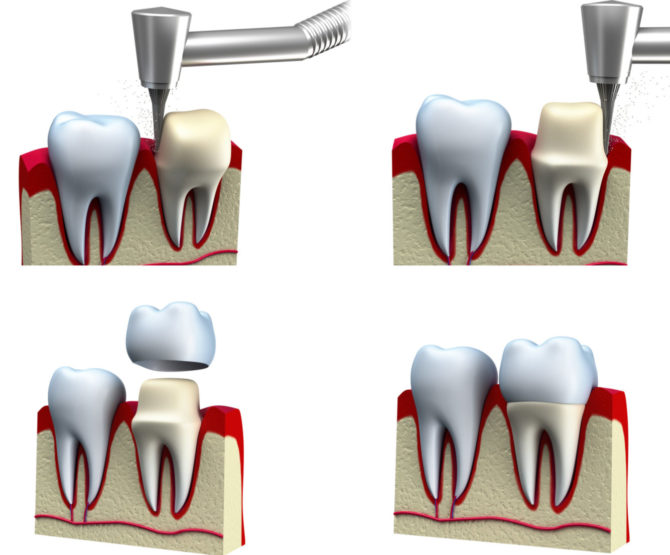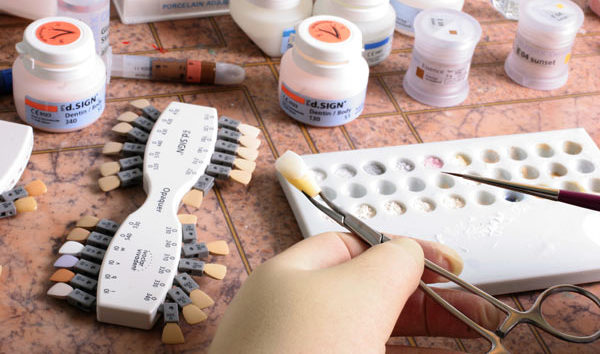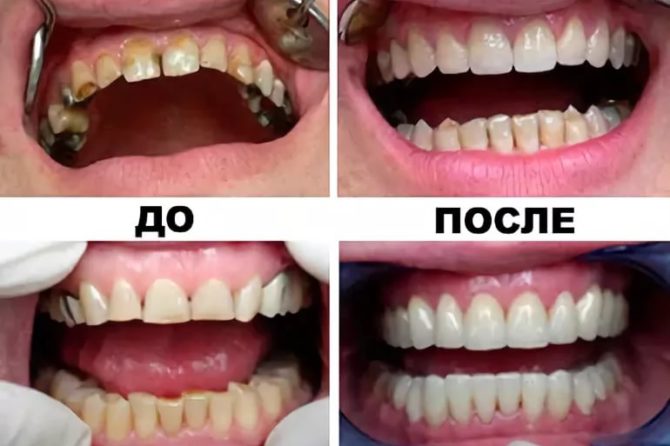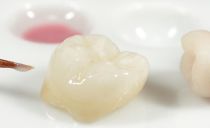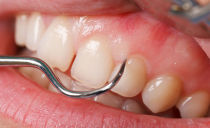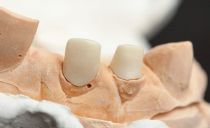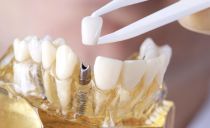Ceramic-metal crowns: what it looks like, pros and cons, installation
Cermet occupies a special niche in dentistry due to reasonable demand. The prostheses from this material combine reasonable cost, high strength and what metal-ceramic crowns look as natural as possible - the photo directly confirms this.
Content
- Cermet prosthesis: types, structure and manufacturing steps
- How to insert metal ceramic teeth
- Ceramic prosthetics on the front and chewing teeth
- Indications and contraindications for installation
- The main pros and cons of cermets
- The choice of cermets taking into account the characteristics of different manufacturers
Cermet prosthesis: types, structure and manufacturing steps
The concept of "cermets" speaks for itself. This is a compound of metal (zirconium dioxide) and ceramics, which has high hypoallergenic properties.
The process of creating a structure begins with the manufacture of a frame base. According to the material of this part, the following types of cermet crowns are distinguished:
- From a heavy-duty medical alloy: nickel and chromium, cobalt and chromium.
- From elite alloys of non-ferrous metals: gold, palladium, platinum.
The use of noble materials enhances strength and hypoallergenicity. Gold alloys not only provide the strength of the metal frame, but also give a natural look to the finished product. In its shade, such a crown accurately imitates a natural tooth, which is why cermet is so common in prosthetics of front incisors and canines.
When the frame base is ready, a ceramic coating is created, this is the final step in the manufacture of cermet. The mass is applied to the frame base by casting or layer-by-layer spraying. Application is the task of the dental technician, performed according to the individual casts of the patient, which allows you to create a prosthesis of maximum accuracy, reliability and convenience.
After manufacturing, the crown is processed in a special furnace: firing at temperatures up to 900 ° C. This provides high adhesion and interaction of the elements of the product.
The methods of applying ceramics differ only in technology, the choice of method does not affect either the strength, nor the quality, or the hypoallergenicity of the prosthesis.
The composite of the product, which has special strength and is immune to external factors, wear resistance and durability, is the optimal way to prosthetics. Ceramic metal dental crowns have a natural and aesthetic appeal.
How to insert metal ceramic teeth
The main stages of prosthetics with cermet:
- preparatory;
- laboratory;
- final.
Preparatory stage
At this stage, the oral cavity is prepared for the subsequent installation of prostheses. The beginning of prosthetics includes the following procedures:
- With the help of radiography, inflammatory processes, dental pathologies are revealed. Dentists determine the treatment regimen, conduct restoration measures of the oral cavity, abutment tooth, and select a crown.
- Dissection of the tooth (the place where the prosthesis is installed) or several.The procedure is mandatory in the presence of inflammatory processes in the root, damage to the tooth, which must be treated to the end. It is necessary to treat a tooth.
- Install a pin or stump tab. The pin is installed in case of damage to half of the hard tissues of the tooth. The stump tab is necessary when it is completely destroyed.
- After conducting medical and restorative procedures, the abutment is sharpened to prepare for casting. The resulting print is sent to the laboratory.
Laboratory stage
It combines the steps of manufacturing a ceramic-metal crown:
- The beginning of work includes the removal of the impression from the tooth - the base. As well as the formation of a plaster model and the frame of the future prosthesis.
- A framework is being made for a gypsum model or for a patient abutment.
- If the fitting was successful, the dentist begins to lay the ceramic mass layer by layer on the metal frame base, after which the finished crown is “baked”.
Final stage
At this stage temporary installation of a ceramic-metal prosthesis, which is possible in the absence of discomfort, the presence of minor crown defects. It is put on a temporary lock. The specialist determines the period of adaptation, getting used to the design. If rejection does not occur, the temporary fixation element is removed, the crown is placed on the tooth with a permanent.
Ceramic prosthetics on the front and chewing teeth
The combination of such positive qualities as wear resistance, strength, durability, natural appearance, allows you to effectively use cermet for prosthetics of different teeth, regardless of their function.
The advantages of ceramic-metal prosthetics for molars
Ceramic crowns for chewing teeth are made most often. The molars are prosthetized with this particular material because of its high strength, immunity to external adverse factors, and wear resistance. These properties allow you to insert the prosthesis while maintaining all the necessary physiological functions.
Despite the fact that the molars are not as visible as the frontal teeth, the installation of a ceramic-metal crown makes it possible not only to preserve the functional purpose of the molars, but also creates an attractive appearance.
Crowns made of metal and ceramics have a wide tint palette that allows you to accurately reproduce the naturalness of an artificial tooth.
Advantages of ceramic-metal prosthetics for incisors and fangs
In the presence of congenital abnormalities leading to the destruction of the front teeth, deterioration, thinning, severe curvature, crowding, they are prosthetized with cermet. By installing a ceramic-metal crown on one tooth or several, the doctor solves not only the tasks of proper functioning.
The hardly distinguishable border of the contact between the crown and gums, the natural color of the prosthesis, the intact gingival integrity, solve the aesthetic issue as efficiently as possible. After installation, the patient can fully smile, teeth with a ceramic-metal composite crown look natural and attractive.
Indications and contraindications for installation
Prosthetics with a ceramic-metal crown are indicated in the following cases:
- lack of one or more teeth;
- tooth is destroyed by more than 50%;
- restoration of the jaw row is necessary;
- odontological pathologies of a hereditary nature;
- diseases that provoke accelerated abrasion, tooth decay;
- restoration of the chewing function of molars;
- recreation of the natural dental form with strong curvature, thinning;
- periodontal disease of primary and secondary degree;
- the inability to carry out orthodontic treatment due to abnormal placement of teeth;
- fixing mobile teeth - splinting;
- severe allergic reactions to metal-plastic crowns;
- acute fluorosis, when enamel is destroyed due to excess fluorine;
- when you need to replace metal, plastic dentures and put new ones.
Ceramic-metal crown is the most suitable solution to eliminate defects in the dentition.
Despite the complex of positive properties and qualities, the use of cermets and its prosthetics have a number of contraindications:
- pregnancy;
- severe periodontal disease;
- foci of inflammation in the oral cavity;
- psychopathology, psycho-emotional disorders;
- malocclusion;
- recovery period after a serious illness;
- ARI, ARVI;
- involuntary contraction of the masticatory muscles - gnashing of teeth;
- allergic reactions to metals used in the manufacture of crowns;
- miniature teeth: inserting a prosthesis does not make sense, the small size of the tooth will not allow the crown to hold.
The main pros and cons of cermets
Metal-ceramic prostheses have a number of advantages and disadvantages, including:
| Advantages | disadvantages |
|---|---|
| Natural color, rich tint palette that allows you to naturally simulate the natural shade and texture of tooth tissue. | Depulpation. The installation of a ceramic-metal crown most often requires the removal of a nerve, cleaning and filling. |
| High functionality. The crown composite, the way metal-ceramic teeth are made under special conditions, allows you to fully recreate the functional task of prosthetics. Molars retain chewing, frontal - biting and aesthetic function. | The need to grind a tooth, due to which up to 2 mm of its own tissue is lost. |
| Creating and maintaining aesthetic appeal. Cermet provides aesthetics of the dentition due to the wide hue-color palette, does not allow the absorption of coloring substances. | Chipping may occur, which occurs with an excessive load on the ceramic-metal crowns. |
| Hypoallergenicity. The risk of allergic reactions in the manufacture of cermets is minimal due to the use of non-toxic materials. | The strength and hardness of the prosthesis can lead to accelerated wear of the teeth of the opposite row. |
| High strength and resistance to external influences. The crown made of ceramic-metal composite withstands the required load. Tightly adhering to the hard tissue of the tooth, the material does not allow its further destruction due to its high resistance to external factors. | Contraindications available. |
| Long service life. Proper care will ensure wearing ceramic-metal crowns for at least 15 years. | — |
| Biocompatibility. The risk of crown rejection is minimal. | — |
| Adequate price. | — |
The choice of cermets taking into account the characteristics of different manufacturers
In order to correctly understand what metal ceramics is, to assess its relevance in dentistry, it is important to understand what technical and practical level this dental field has reached. In the production of materials for ceramic-metal crowns they use the latest technologies and scientific discoveries to improve their products:
- Innovative developments allow the ceramic mass used by the brand to acquire special properties that prevent the accumulation of plaque on the tooth surface. These qualities ensure the preservation of the original form several years after prosthetics.
- Ceramic mass contains the smallest crystals, significantly increasing its strength, wear resistance and service life. Advanced ceramics prevent chips and other defects.
- Vita VM 13. Materials for the manufacture of prostheses represent the latest achievement of German scientists in the field of cermet.Crowns have reflective, light-refracting properties that match those of natural enamel. This allows you to make the most natural prostheses.
- Duceram dentures with the highest esthetic properties. Coloring materials and ceramics used in the manufacture of these crowns, as accurately as possible recreate natural tooth enamel. This allows you to make prostheses that are visually almost impossible to distinguish from natural teeth.
Ceramic-metal prosthetics is relevant not only in Moscow, but also in other Russian cities. In order not to be afraid of this procedure, it is necessary to understand what a crown made of metal and ceramics is, to know the pros and cons of a prosthesis, situations where ceramic-metal crowns are placed necessarily, and when it is contraindicated. The necessary knowledge will allow you to choose and install the most suitable product, make the smile beautiful and healthy.

